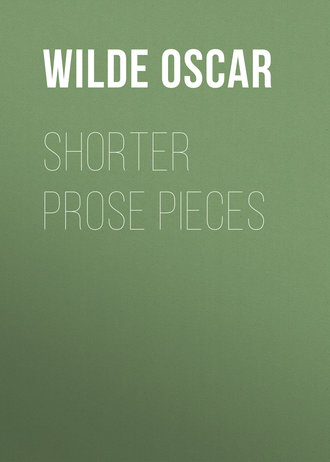
Оскар Уайльд
Shorter Prose Pieces
PHRASES AND PHILOSOPHIES FOR THE USE OF THE YOUNG
The first duty in life is to be as artificial as possible. What the second duty is no one has as yet discovered.
Wickedness is a myth invented by good people to account for the curious attractiveness of others.
If the poor only had profiles there would be no difficulty in solving the problem of poverty.
Those who see any difference between soul and body have neither.
A really well-made buttonhole is the only link between Art and Nature.
Religions die when they are proved to be true. Science is the record of dead religions.
The well-bred contradict other people. The wise contradict themselves.
Nothing that actually occurs is of the smallest importance.
Dulness is the coming of age of seriousness.
In all unimportant matters, style, not sincerity, is the essential.
In all important matters, style, not sincerity, is the essential.
If one tells the truth one is sure, sooner or later, to be found out.
Pleasure is the only thing one should live for. Nothing ages like happiness.
It is only by not paying one's bills that one can hope to live in the memory of the commercial classes.
No crime is vulgar, but all vulgarity is crime. Vulgarity is the conduct of others.
Only the shallow know themselves.
Time is waste of money.
One should always be a little improbable.
There is a fatality about all good resolutions. They are invariably made too soon.
The only way to atone for being occasionally a little overdressed is by being always absolutely overeducated.
To be premature is to be perfect.
Any preoccupation with ideas of what is right or wrong in conduct shows an arrested intellectual development.
Ambition is the last refuge of the failure.
A truth ceases to be true when more than one person believes in it.
In examinations the foolish ask questions that the wise cannot answer.
Greek dress was in its essence inartistic. Nothing should reveal the body but the body.
One should either be a work of art, or wear a work of art.
It is only the superficial qualities that last. Man's deeper nature is soon found out.
Industry is the root of all ugliness.
The ages live in history through their anachronisms.
It is only the gods who taste of death. Apollo has passed away, but Hyacinth, whom men say he slew, lives on. Nero and Narcissus are always with us.
The old believe everything: the middle-aged suspect everything; the young know everything. The condition of perfection is idleness: the aim of perfection is youth.
Only the great masters of style ever succeeded in being obscure.
There is something tragic about the enormous number of young men there are in England at the present moment who start life with perfect profiles, and end by adopting some useful profession.
To love oneself is the beginning of a life-long romance.
MRS. LANGTRY AS HESTER GRAZEBROOK
It is only in the best Greek gems, on the silver coins of Syracuse, or among the marble figures of the Parthenon frieze, that one can find the ideal representation of the marvellous beauty of that face which laughed through the leaves last night as Hester Grazebrook.
Pure Greek it is, with the grave low forehead, the exquisitely arched brow; the noble chiselling of the mouth, shaped as if it were the mouthpiece of an instrument of music; the supreme and splendid curve of the cheek; the augustly pillared throat which bears it all: it is Greek, because the lines which compose it are so definite and so strong, and yet so exquisitely harmonized that the effect is one of simple loveliness purely: Greek, because its essence and its quality, as is the quality of music and of architecture, is that of beauty based on absolutely mathematical laws.
But while art remains dumb and immobile in its passionless serenity, with the beauty of this face it is different: the grey eyes lighten into blue or deepen into violet as fancy succeeds fancy; the lips become flower-like in laughter or, tremulous as a bird's wing, mould themselves at last into the strong and bitter moulds of pain or scorn. And then motion comes, and the statue wakes into life. But the life is not the ordinary life of common days; it is life with a new value given to it, the value of art: and the charm to me of Hester Grazebrook's acting in the first scene of the play last night was that mingling of classic grace with absolute reality which is the secret of all beautiful art, of the plastic work of the Greeks and of the pictures of Jean Francois Millet equally.
I do not think that the sovereignty and empire of women's beauty has at all passed away, though we may no longer go to war for them as the Greeks did for the daughter of Leda. The greatest empire still remains for them – the empire of art. And, indeed, this wonderful face, seen last night for the first time in America, has filled and permeated with the pervading image of its type the whole of our modern art in England. Last century it was the romantic type which dominated in art, the type loved by Reynolds and Gainsborough, of wonderful contrasts of colour, of exquisite and varying charm of expression, but without that definite plastic feeling which divides classic from romantic work. This type degenerated into mere facile prettiness in the hands of lesser masters, and, in protest against it, was created by the hands of the Pre-Raphaelites a new type, with its rare combination of Greek form with Florentine mysticism. But this mysticism becomes over- strained and a burden, rather than an aid to expression, and a desire for the pure Hellenic joy and serenity came in its place; and in all our modern work, in the paintings of such men as Albert Moore and Leighton and Whistler, we can trace the influence of this single face giving fresh life and inspiration in the form of a new artistic ideal.
SLAVES OF FASHION
Miss Leffler-Arnim's statement, in a lecture delivered recently at St. Saviour's Hospital, that "she had heard of instances where ladies were so determined not to exceed the fashionable measurement that they had actually held on to a cross-bar while their maids fastened the fifteen-inch corset," has excited a good deal of incredulity, but there is nothing really improbable in it. From the sixteenth century to our own day there is hardly any form of torture that has not been inflicted on girls, and endured by women, in obedience to the dictates of an unreasonable and monstrous Fashion. "In order to obtain a real Spanish figure," says Montaigne, "what a Gehenna of suffering will not women endure, drawn in and compressed by great coches entering the flesh; nay, sometimes they even die thereof!" "A few days after my arrival at school," Mrs. Somerville tells us in her memoirs, "although perfectly straight and well made, I was enclosed in stiff stays, with a steel busk in front; while above my frock, bands drew my shoulders back till the shoulder-blades met. Then a steel rod with a semi-circle, which went under my chin, was clasped to the steel busk in my stays. In this constrained state I and most of the younger girls had to prepare our lessons"; and in the life of Miss Edgeworth we read that, being sent to a certain fashionable establishment, "she underwent all the usual tortures of back- boards, iron collars and dumbs, and also (because she was a very tiny person) the unusual one of being hung by the neck to draw out the muscles and increase the growth," a signal failure in her case. Indeed, instances of absolute mutilation and misery are so common in the past that it is unnecessary to multiply them; but it is really sad to think that in our own day a civilized woman can hang on to a cross-bar while her maid laces her waist into a fifteen- inch circle. To begin with, the waist is not a circle at all, but an oval; nor can there be any greater error than to imagine that an unnaturally small waist gives an air of grace, or even of slightness, to the whole figure. Its effect, as a rule, is simply to exaggerate the width of the shoulders and the hips; and those whose figures possess that stateliness which is called stoutness by the vulgar, convert what is a quality into a defect by yielding to the silly edicts of Fashion on the subject of tight-lacing. The fashionable English waist, also, is not merely far too small, and consequently quite out of proportion to the rest of the figure, but it is worn far too low down. I use the expression "worn" advisedly, for a waist nowadays seems to be regarded as an article of apparel to be put on when and where one likes. A long waist always implies shortness of the lower limbs, and, from the artistic point of view, has the effect of diminishing the height; and I am glad to see that many of the most charming women in Paris are returning to the idea of the Directoire style of dress. This style is not by any means perfect, but at least it has the merit of indicating the proper position of the waist. I feel quite sure that all English women of culture and position will set their faces against such stupid and dangerous practices as are related by Miss Leffler-Arnim. Fashion's motto is: Il faut souffrir pour etre belle; but the motto of art and of common-sense is: Il faut etre bete pour souffrir.
Talking of Fashion, a critic in the Pall Mall Gazelle expresses his surprise that I should have allowed an illustration of a hat, covered with "the bodies of dead birds," to appear in the first number of the Woman's World; and as I have received many letters on the subject, it is only right that I should state my exact position in the matter. Fashion is such an essential part of the mundus muliebris of our day, that it seems to me absolutely necessary that its growth, development, and phases should be duly chronicled; and the historical and practical value of such a record depends entirely upon its perfect fidelity to fact. Besides, it is quite easy for the children of light to adapt almost any fashionable form of dress to the requirements of utility and the demands of good taste. The Sarah Bernhardt tea-gown, for instance, figured in the present issue, has many good points about it, and the gigantic dress-improver does not appear to me to be really essential to the mode; and though the Postillion costume of the fancy dress ball is absolutely detestable in its silliness and vulgarity, the so-called Late Georgian costume in the same plate is rather pleasing. I must, however, protest against the idea that to chronicle the development of Fashion implies any approval of the particular forms that Fashion may adopt.






